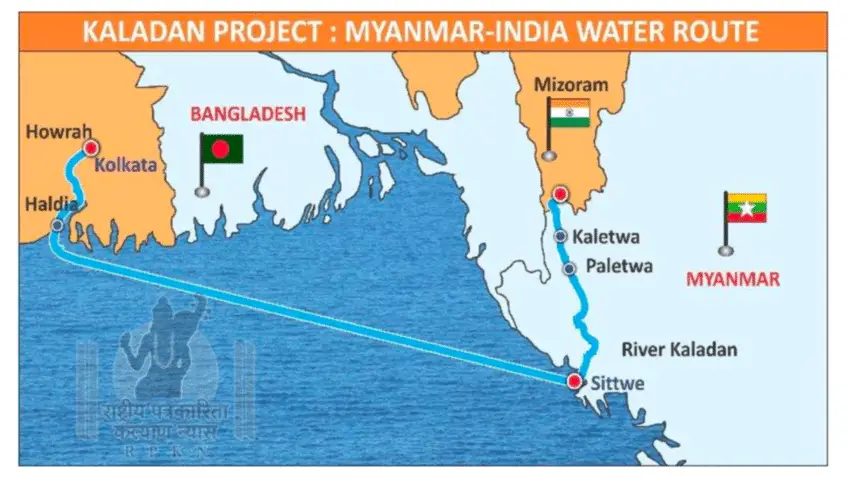
Why in The News?
The Kaladan Multi-Modal Transit Transport Project, aimed at enhancing connectivity between India and Myanmar, is experiencing significant delays owing to the prevailing political crisis in Myanmar. This crisis has led to disruptions in the project’s implementation, including delays in construction activities, logistical challenges, and uncertainties regarding project timelines. The ongoing political instability in Myanmar has hindered the smooth execution of the Kaladan project, affecting its progress and causing setbacks to its completion schedule. As a result, stakeholders are closely monitoring the situation and exploring potential strategies to mitigate the impact of the crisis on the project’s advancement.
Background
- The Kaladan Multi-Modal Transit Transport Project was a collaborative effort between India and Myanmar, strategically aimed at enhancing transportation links.
- Its primary objective was to establish a multi-modal mode of transport to facilitate the efficient shipment of cargo from the eastern ports of India to various destinations within Myanmar.
- The project was envisioned as a crucial step towards bolstering trade and economic ties between the two nations, providing a vital lifeline for the movement of goods and commodities.
- Through the development of road, river, and sea routes, the project aimed to streamline the transportation process, reducing logistical challenges and enhancing connectivity across the region.
- By leveraging multiple modes of transport, including roads, rivers, and ports, the Kaladan project sought to create an integrated transport network that would catalyze economic development and promote regional cooperation.
Detail of The Kaladan Multi-Modal Transit Transport Project
The Kaladan Multi-Modal Transit Transport Project is a crucial infrastructure initiative aimed at enhancing connectivity between eastern India and Myanmar. Here are its key components:
- Sea Route: The project connects the eastern Indian seaport of Kolkata with the Sittwe seaport in Rakhine State, Myanmar, through a sea route. This linkage significantly reduces the distance between Kolkata and Sittwe by approximately 1,328 kilometers, thereby facilitating more efficient maritime trade between the two regions.
- River Route: Within Myanmar, the project extends from the Sittwe seaport to Paletwa in Chin State via the Kaladan River boat route. This river route serves as a vital link, enabling the transportation of goods and materials inland, further enhancing connectivity and trade opportunities.
- Road Connectivity: From Paletwa, located in close proximity to the Bangladesh border, the project extends by road to Mizoram state in Northeast India. This road connectivity is crucial for facilitating seamless transportation of goods and people between Myanmar and India, particularly benefiting the northeastern states of India, which are often geographically isolated from the mainland.
Significance of the project
A) Economic Significance:
- Distance Reduction: By reducing the distance from Kolkata to Sittwe by approximately 1,328 kilometers, the project offers a significant advantage in terms of transportation efficiency. This reduction in distance minimizes travel time and associated costs, making trade between the two regions more competitive.
- Alternative Trade Route: The Kaladan Multi-Modal Transit Transport Project provides an alternative trade route that bypasses the narrow Siliguri corridor, which is prone to congestion and geopolitical vulnerabilities. By diversifying trade routes, the project enhances the resilience of India’s trade infrastructure and reduces dependency on traditional routes.
- Connectivity to North-Eastern States: The connection of Sittwe Port in Myanmar to the India-Myanmar border is a crucial aspect of the project. It opens up new avenues for trade and commerce, particularly benefiting the North-Eastern States of India. These states, often geographically isolated, will now have access to sea routes, facilitating the export and import of goods and fostering economic development in the region.
B) Strategic Significance:
- Expansion of Strategic Footprints: The Kaladan Multi-Modal Transit Transport Project holds significant importance in enhancing India’s strategic presence in East Asia and particularly in its immediate neighborhood. By establishing a robust transportation corridor, India strengthens its connectivity with Southeast Asian countries, fostering closer diplomatic, economic, and security ties in the region.
- Reduction of Dependency on Chicken’s Neck: The Kaladan Multi-Modal Transit Transport project offers a crucial alternative to the narrow Siliguri corridor, often referred to as the Chicken’s Neck. This alternative route not only mitigates the risk of congestion and disruptions but also enhances India’s control over its northeastern frontier. By diversifying transportation routes, India reduces its logistical vulnerabilities and strengthens its strategic posture along its eastern border.
- Alignment with Act East Policy: The Kaladan project aligns closely with India’s Act East Policy, which aims to deepen engagement with Southeast Asia and enhance connectivity with the region. By bolstering transportation links with Myanmar and other Southeast Asian nations, the project reinforces India’s commitment to regional integration, economic cooperation, and strategic partnerships in the Asia-Pacific region.
- Boost to Regional Economy: The project is expected to contribute significantly to the economic development of the North-Eastern States of India by expanding their access to international markets. The availability of a sea route for transporting products will lower transportation costs and improve market access for local businesses, thereby stimulating economic growth and employment opportunities in the region.
- Trade Facilitation: By connecting Sittwe Port to the India-Myanmar border, the project streamlines trade activities between the two countries. It enhances bilateral trade relations, promotes cross-border investments, and fosters economic cooperation, ultimately benefiting the economies of both India and Myanmar.
Thank you for your sharing. I am worried that I lack creative ideas. It is your article that makes me full of hope. Thank you. But, I have a question, can you help me?
Your article helped me a lot, is there any more related content? Thanks!
Your article helped me a lot, is there any more related content? Thanks!